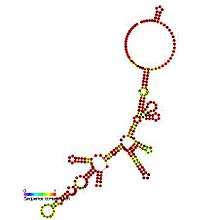Pestivirus internal ribosome entry site (IRES)
| Pestivirus internal ribosome entry site (IRES) | |
|---|---|
 | |
| Predicted secondary structure and sequence conservation of IRES_Pesti | |
| Identifiers | |
| Symbol | IRES_Pesti |
| Alt. Symbols | Pesti_IRES |
| Rfam | RF00209 |
| Other data | |
| RNA type | Cis-reg; IRES |
| Domain(s) | Viruses |
| GO | 0043022 |
| SO | 0000243 |
This family represents the internal ribosome entry site (IRES) of the pestiviruses. The pestivirus IRES allows cap and end-independent translation of mRNA in the host cell. The IRES achieves this by mediating the internal initiation of translation by recruiting a ribosomal 43S pre-initiation complex directly to the initiation codon and eliminates the requirement for the eukaryotic initiation factor, eIF4F.[1] The classical swine fever virus UTR described appears to be longer at the 5' end than other pestivirus UTRs.[1] This family represents the conserved core.
References
- 1 2 Kolupaeva, VG; Pestova TV; Hellen CU (2000). "Ribosomal binding to the internal ribosomal entry site of classical swine fever virus". RNA. 6 (12): 1791–1807. doi:10.1017/S1355838200000662. PMC 1370049
 . PMID 11142379.
. PMID 11142379.
External links
This article is issued from Wikipedia - version of the 7/21/2014. The text is available under the Creative Commons Attribution/Share Alike but additional terms may apply for the media files.